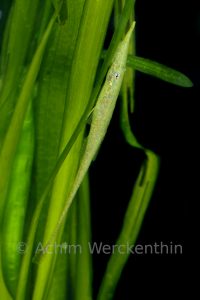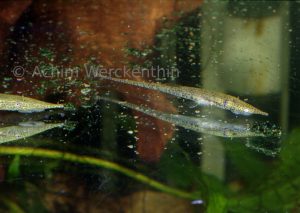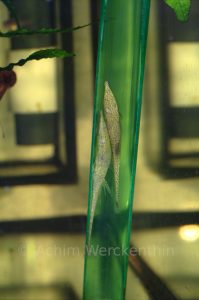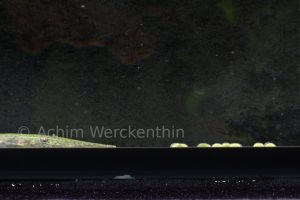These fragile-looking loricariids look like smaller representatives of the stick-catfish of the genus Farlowella and are known to only a few aquarium hobbyists.
 Yet they are not even related to them. Surprisingly, we are dealing with a case of convergent evolution, in which such a similar way of life obviously led to the development of an almost identical body shape during the process of evolution.
Yet they are not even related to them. Surprisingly, we are dealing with a case of convergent evolution, in which such a similar way of life obviously led to the development of an almost identical body shape during the process of evolution.
Although the type species of the genus Acestridium was already described in 1911, these fishes were absolute phantoms for us aquarists only a few years ago. In the meantime, however, even one or the other species is being introduced for aquaristics from time to time. Especially the green-coloured Acestridium dichromum caused a lot of desire among hobbyists. However, these fish never achieved wider distribution and greater popularity due to their high demands and great fragility when treated under suboptimal conditions. The so-called “dwarf-stick-catfish” are fish for absolute specialists.
Systematics of the genus
After the genus Acestridium with its type species A. discus was described by HASEMAN as early as 1911, it was not until the last millennium that two further species were described. RETZER, NICO & PROVVENZANO (1999) described the species A. dichromum and A. martini, which are now also known to aquarists. To date, four more descriptions have been published: A. colombiensis, A. gymnogaster, A. scutatum and A. triplax.
Recent phylogenetic studies on the classification of the genus Acestridium within the loricariid family by RODRIGUEZ, DELAPIEVE & REIS (2015) place Acestridium within the subfamily of Hypoptopomatinae and the genus group Hypoptopomatini, right in immediate relationship to the genera Hypoptopoma and Oxyropsis, which are much better known to us aquarists and which, as it turns out, also engage in breeding in a similar manner. The closest relative, however, is said to be Niobichthys ferrarisi, a species known only from museum specimens. Species of the genus Farlowella, on the other hand, are classified in the subfamily Loricariinae in the tribe Loricariini and further in the subtribe Sturisomina.
Acestridium can be easily identified by some characteristics. Apart from various bony features, the very slender, elongated and flattened body in combination with a strongly elongated head section, which shows a club-like thickening at the end, are unique within the family of loricariid catfishes. The rostrum is very strongly covered with short skin teeth (odontodes). The ventral sucking mouth is quite large and oval shaped. Unlike some other hypoptopomatines, Acestridium lack an adipose fin. The maximum length of these fishes is usually between 5-7 cm.
The fishes in the wild
The distribution range of the genus Acestridium extends from the upper reaches of the Río Orinoco (A. colombiensis, A. dichromum and A. martini) via the Rio Negro (A. dichromum, A. discus and A. martini) to some southern tributaries of the Amazon. A. gymnogaster and A. scutatum have been described from the Rio Madeira basin and A. triplax from the Rio Tapajós basin. They are inhabitants of quite warm waters of the South American lowlands, which usually have water temperatures between 25 and 30 °C. They are usually very soft and have a very low temperature. Usually the soft waters of the clear or black water type with hardly detectable water hardness have an acidic to slightly acidic pH.
The second author (IS) was able to detect the species Acestridium martini in April 2001 at its type locality, Caño Pozo Azul, in southern Venezuela (Est. Amazon). He observed this brown-coloured species mainly on dead aquatic vegetation in light currents. The water temperature of this quite clear jungle stream was 28 °C at the time of the measurement. The extremely soft water had a pH value of 5.6. The animals were obviously grazing the growth on the plant parts there.
In 2015, Stefan K. HETZ found an Acestridium species, which is probably A. colombiensis, in the Caño Bocon, a tributary of the Río Inirida in Colombia. The species lives here in shallow (50-60 cm), very soft black water.
RETZER et. al (1999) describe the way of life of A. dichromum and A. martini quite extensively. They occur in the lowlands below 150 m altitude in black and clear waters. The two species were encountered in stretches of water with low to medium flow, visibility was usually above 2 m. Water temperatures of 25-29 °C and pH values in the range of 4.5 to 5.5 were measured in the different water bodies. Acestridium dichromum was observed mainly on aquatic and semi-aquatic vegetation, A. martini sometimes stayed in the same habitats on plant roots or dead plant parts. A. dichromum was observed to change its colouration and to turn brownish on a brown background.
How to care for them in the aquarium
 Acestridium are no fish for the classic community aquarium. One should be uncompromising about the needs of the animals right from the start, otherwise success will almost certainly not be achieved. However, as is often the case, Acestridium species can be kept for a long time and can certainly be bred if you get to understand their requirements. First, it is advisable to acquire the animals, which are inevitably weakened by the import, as soon as possible, if they are ever offered, to ensure the best possible care. The aquarium should not be too large, especially during the acclimatisation phase (a 60 cm standard tank is very suitable) and preferably should not contain any substrate to allow better feeding circumstances. Since Acestridium species naturally occur in soft, acidic and consequently germ-poor water, you should take this into account with appropriate water values. For the first author (AW), an electrical conductivity of less than 100 µS/cm and a pH of 4.5 to 6.0, at 25-28 °C and good aeration of the water have proved successful. You should know something about water chemistry, as very soft water, especially if you acidify it, can quickly lead to a disaster if you are not careful. The reader is referred to the relevant literature, for example to a very informative article by HETZ (2005). As with many soft water species, however, maintenance is probably possible even with greater water hardness and higher pH values, if one can ensure that the water is appropriately low in germs. MEUSCHKE (pers. communication), for example, was able to maintain A. dichromum and A. discus for about two years at a neutral pH and medium water hardness (12-14 °dGH, 3 °KH).
Acestridium are no fish for the classic community aquarium. One should be uncompromising about the needs of the animals right from the start, otherwise success will almost certainly not be achieved. However, as is often the case, Acestridium species can be kept for a long time and can certainly be bred if you get to understand their requirements. First, it is advisable to acquire the animals, which are inevitably weakened by the import, as soon as possible, if they are ever offered, to ensure the best possible care. The aquarium should not be too large, especially during the acclimatisation phase (a 60 cm standard tank is very suitable) and preferably should not contain any substrate to allow better feeding circumstances. Since Acestridium species naturally occur in soft, acidic and consequently germ-poor water, you should take this into account with appropriate water values. For the first author (AW), an electrical conductivity of less than 100 µS/cm and a pH of 4.5 to 6.0, at 25-28 °C and good aeration of the water have proved successful. You should know something about water chemistry, as very soft water, especially if you acidify it, can quickly lead to a disaster if you are not careful. The reader is referred to the relevant literature, for example to a very informative article by HETZ (2005). As with many soft water species, however, maintenance is probably possible even with greater water hardness and higher pH values, if one can ensure that the water is appropriately low in germs. MEUSCHKE (pers. communication), for example, was able to maintain A. dichromum and A. discus for about two years at a neutral pH and medium water hardness (12-14 °dGH, 3 °KH).
Regular, generous water changes and a good filtration are a matter too of course. As with many more sensitive fish, special care must be taken to ensure that “once things are going well”, no carelessness sets in, which then quickly takes its revenge in the form of losses. The animals can certainly be socialised with small carnivorous fish, such as small tetras or barbs, which come from similar waters. Examples of this are the Tucano tetra (Tucanoichthys tukano) or the Morse code tetra (Characidae sp.), of which the first author has some offspring swimming in the Acestridium tank. However, it is better to avoid socialisation with fish that are not yet acclimatised. Direct food competitors, such as other herbivorous loricariids, or hectic co-inhabitants should be avoided at all costs.
The aquarium setup should be rather spartan so that you can observe the animals well and clean the aquarium easily. The animals spend most of their time on the glass or on other smooth objects, such as filter pipes, etc. Otherwise, you need to make sure that they cannot get stuck anywhere. For example, the first author lost a spawning female that swam into a pipe that was not completely sealed at the bottom and was given into the aquarium as a spawning substrate and could not find its way out.
Feeding
 Probably the most important point in the care of Acestridium is the food and a permanent, reliable diet. Therefore, we will go into more detail here. In our experience, frozen food as well as most granulated and dry food is usually ignored. They accept fine flake food or vegetable-based food tablets relatively well, especially if they have a high Spirulina or Chlorella content. In addition, you can feed Artemia nauplii, which are well eaten too. Also, algae-covered stones that are placed in the tank and regularly replaced are readily accepted. However, this can hardly be done on a permanent basis by an aquarist, so you usually need to rely on artificial food. According to MEUSCHKE (personal communication), natural, 3.5% organic yoghurt has also proven to be good for acclimatisation. Add 3-5 ml/50 litres of this to the water. The first author has been using the following food mixture successfully for some time: pure Spirulina powder (10), pure Chlorella powder (10), vegetable-based flake food (42.5), “normal” flake food (20), some sweet pepper (2.5) and a small amount of fine granulated food (5, details in parentheses are volume parts of the uncrushed starting components).
Probably the most important point in the care of Acestridium is the food and a permanent, reliable diet. Therefore, we will go into more detail here. In our experience, frozen food as well as most granulated and dry food is usually ignored. They accept fine flake food or vegetable-based food tablets relatively well, especially if they have a high Spirulina or Chlorella content. In addition, you can feed Artemia nauplii, which are well eaten too. Also, algae-covered stones that are placed in the tank and regularly replaced are readily accepted. However, this can hardly be done on a permanent basis by an aquarist, so you usually need to rely on artificial food. According to MEUSCHKE (personal communication), natural, 3.5% organic yoghurt has also proven to be good for acclimatisation. Add 3-5 ml/50 litres of this to the water. The first author has been using the following food mixture successfully for some time: pure Spirulina powder (10), pure Chlorella powder (10), vegetable-based flake food (42.5), “normal” flake food (20), some sweet pepper (2.5) and a small amount of fine granulated food (5, details in parentheses are volume parts of the uncrushed starting components).
The vegetable part should predominate, and especially the pure Spirulina and Chlorella powder (both can be bought cheaply in large quantities outside the pet shop) seem to be important here. Grind the whole thing until everything is well mixed and a coarse powder is formed. The finished food mixture has a very dark green colour and appears almost black, due to the high algae content. Also, rather herbivorous, loricariine loricariid catfish, such as Sturisomatichthys, can be raised very well with this food. The food should be stored dry and cool in the refrigerator or freezer, as it attracts water very easily. When feeding, you can form lumps of food with your fingers under water, which sink to the bottom and disintegrate there. This prevents too much food from being distributed in the water. This also explains why the lack of substrate plays an important role in feeding: To get the food to the fish at all, it seems to be important that they can practically “suck in” the fine food particles from a smooth surface (see video). Of course, food remains should be removed the next day at the latest, as spoiled food is sometimes eaten and can lead to the death of the animals.
Gender differences and reproduction
In A. discus (first author’s observations) and A. dichromum (MEUSCHKE, pers. commun.) the females usually seem to be considerably larger, and at least in acclimated animals the females are usually broader. Once you have managed to feed the animals into spawning mood, the difference is obvious, as females become more voluminous. There also seem to be differences in the shape of the genital papilla, although this is not always clearly visible.
 The first partial success in reproducing an Acestridium species was probably achieved by SCHLÜTER (see EVERS & SEIDEL, 2005). He reported relatively large, greenish-oval eggs that were found distributed in the aquarium and died relatively soon. The first author (AW) was able to make observations on the spawning behaviour of a single pair of A. discus. The male always preferred a place near the filter current. The animals seem to be quite choosy in choosing a spawning site, clear spawning preparations were aborted several times because the spawning site did not seem to fit. The initiative for spawning obviously comes from the female, which pushes herself next to the male at his place. Spawning has so far always taken place during the day, and the courtship and cleaning of the spawning site can last for several days (see video). The animals spawn few (about 10), in relation to the body size with 2.5-3mm very large, oval eggs. They resemble the genus Farlowella in this, which also produces oval eggs as a special feature within the family Loricariidae. Like the related Hypoptopoma, Nannoptopoma and Oxyropsis species (see WENDENBURG (1998), Weidner and DOTZER & WEIDNER in EVRS & SEIDEL 2005), the Acestridium males guard and care for the clutch.
The first partial success in reproducing an Acestridium species was probably achieved by SCHLÜTER (see EVERS & SEIDEL, 2005). He reported relatively large, greenish-oval eggs that were found distributed in the aquarium and died relatively soon. The first author (AW) was able to make observations on the spawning behaviour of a single pair of A. discus. The male always preferred a place near the filter current. The animals seem to be quite choosy in choosing a spawning site, clear spawning preparations were aborted several times because the spawning site did not seem to fit. The initiative for spawning obviously comes from the female, which pushes herself next to the male at his place. Spawning has so far always taken place during the day, and the courtship and cleaning of the spawning site can last for several days (see video). The animals spawn few (about 10), in relation to the body size with 2.5-3mm very large, oval eggs. They resemble the genus Farlowella in this, which also produces oval eggs as a special feature within the family Loricariidae. Like the related Hypoptopoma, Nannoptopoma and Oxyropsis species (see WENDENBURG (1998), Weidner and DOTZER & WEIDNER in EVRS & SEIDEL 2005), the Acestridium males guard and care for the clutch.
Unfortunately, the eggs did not develop in three clutches produced so far, although they were at least partially fertilised. In two cases, the male chose the bottom silicone seam as spawning place, and the eggs did not adhere permanently to this and detached after one day at the latest. In another spawning attempt, the eggs were apparently simply rejected by the female for unknown reasons after a longer period of courtship. Green plastic tubes of about 1-2 cm diameter, which were positioned in the filter current after the first spawning runs, are well accepted by the male, but unfortunately spawning has not yet occurred here. Unfortunately, artificial breeding has failed so far, the eggs always died at the latest half a day after being removed. Whether the lack of adhesion is due to insufficient water parameters still needs to be clarified. There were about 4 and 6 months between the individual spawnings, but the female was already clearly ready to spawn beforehand and the animals were in direct contact with each other for a longer period of time, but without spawning. Well-conditioned animals seem to spawn regularly, similarly to many loricariine loricariids (Sturisoma, Sturisomatichthys, Farlowella) without a special stimulation, which gives hope for successful offspring!
Finally, we would like to thank Hans-Georg EVERS (Hamburg), Stefan K. HETZ (Berlin) and Mike MEUSCHKE (Gera) for information and illustrations, without which this article would not have been possible in its present form!
Literature:
- EVERS, H.-G. & I. SEIDEL (2005): Wels Atlas Band 1, 2. erweitere Auflage, Mergus Verlag GmbH, Melle: 942 S. 285 ff.
- HASEMAN, J. D. (1911): Descriptions of some new species of fishes and miscellaneous notes on others obtained during the expedition of the Carnegie Museum to central South America. Annals of the Carnegie Museum, 7 (nos 3-4) (17): 315-328, Pls. 46-52.
- HETZ, S. K. (2005): Schwarzwasser – aus der Sicht der Fische. D. Aqu. u. Terr. Z. (DATZ), 58(9): 24-29.
- RETZER, M. E., L. G. NICO & F. PROVENZANO (1999): Two new species of Acestridium (Siluriformes: Loricariidae) from southern Venezuela, with observations on camouflage and color change. Ichthyological Exploration of Freshwaters, 10(4): 313-326.
- RODRIGUEZ, M. S., M. L. S. DELAPIEVE & R. E. REIS (2015): Phylogenetic relationships of the species of Acestridium Haseman, 1911 (Siluriformes: Loricariidae). Neotropical Ichthyology, 13(2): 325-340.
- WENDENBURG, H. (1998): Joberts Harnischwels. Zur erfolgreichen Nachzucht von Hypoptopoma cf. joberti. Das Aquarium, 32(346): 2-8.
Text: Achim WERCKENTHIN & Ingo SEIDEL – Pictures: Achim WERCKENTHIN
This article has been published in the German magazine Amazonas (Nov/Dec 2017) first, several images were added there and are not shown here.